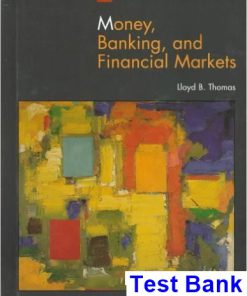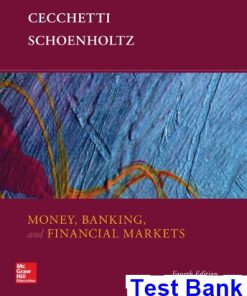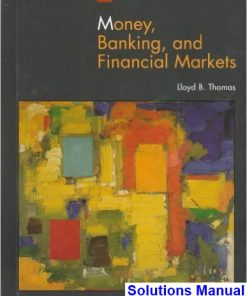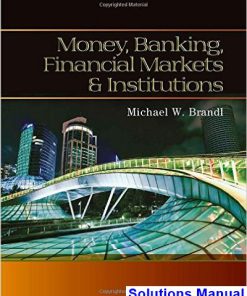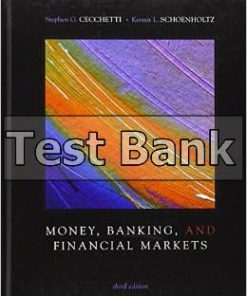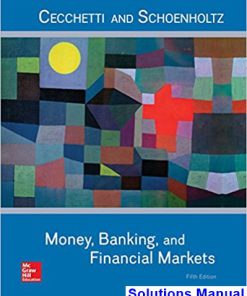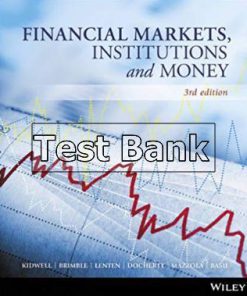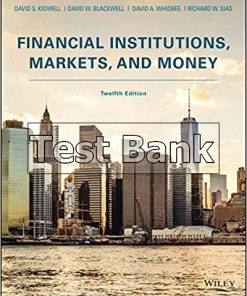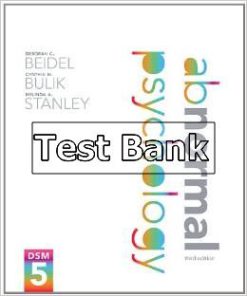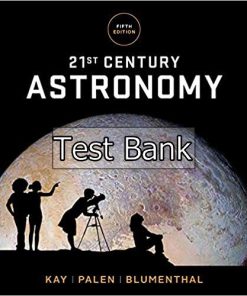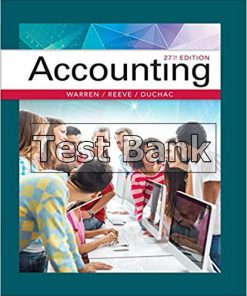Money Banking Financial Markets and Institutions 1st Edition Brandl Test Bank
$50.00 Original price was: $50.00.$26.50Current price is: $26.50.
Money Banking Financial Markets and Institutions 1st Edition Brandl Test Bank.
This is completed downloadable of Money Banking Financial Markets and Institutions 1st Edition Brandl Test Bank
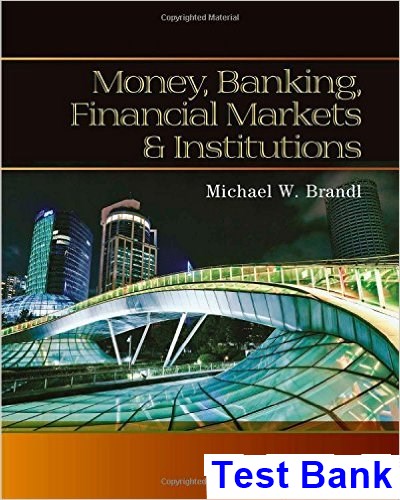
Product Details:
- ISBN-10 : 0538748575
- ISBN-13 : 978-0538748575
- Author: Michael Brandl
Brandl’s MONEY, BANKING, FINANCIAL MARKETS AND INSTITUTIONS brings key financial concepts to life in a clear, concise manner. You clearly see the links between macroeconomics and the money and banking course as you examine financial entities in detail, using the recent economic crisis as a backdrop. This unique, inviting book reads almost as a conversation that encourages you to discuss and debate these important concepts with friends, colleagues and future employers. Leading MindTap and Aplia online learning and homework tools available with this book further enhance the book’s reader-friendly approach and prepares you with the understanding of banking and financial markets you need for future success.
Table of Content:
- Ch 1: Introduction
- 1-1: Why Study This Stuff?
- 1-2: The Key Components
- Ch 2: Money, Money Supply, and Interest
- 2-1: The Concept of Money
- 2-2: Amount of Money and Money through Time
- 2-3: Money Supplies
- 2-4: The Price of Money: Interest Rates
- 2-5: Conclusion
- Ch 3: Bonds and Loanable Funds
- 3-1: Bonds Defined and Explained
- 3-2: Bond Prices and Yields
- 3-3: Supply and Demand for Bonds
- 3-4: Supply and Demand for Loanable Funds
- 3-5: The Bond Market and Loanable Funds Market Compared
- 3-6: Conclusion
- Ch 4: Interest Rates in More Detail
- 4-1: Interest Rates in More Detail and Default Risk
- 4-2: Real versus Nominal: The Role of Inflation
- 4-3: Taxes
- 4-4: Yield Curves
- 4-5: Yield Curve Applications
- 4-6: Conclusion
- Summary of Money and Its Prices
- Ch 5: Financial Markets through Time
- 5-1: US Financial Markets in the Early Twentieth Century
- 5-2: Federal Reserve in the Early Days
- 5-3: Financial Markets during World War II
- 5-4: Postwar Boom: Home Mortgages, Consumerism, and European Unification
- 5-5: Effects of Stagflation and the Reagan/Thatcher Revolution on Financial Markets
- 5-6: Savings & Loans and Junk Bonds
- 5-7: Conclusion
- Ch 6: Aggregate Supply and Aggregate Demand
- 6-1: Introduction and Keynes’s Aggregate Demand
- 6-2: Shifts in Aggregate Demand
- 6-3: Aggregate Supply
- 6-4: The Rational Expectations Approach to AS/AD
- 6-5: Business Cycles
- 6-6: Conclusion
- Ch 7: Banks and Money
- 7-1: Why Banks Exist: Asymmetric Information
- 7-2: Adverse Selection in Financial Markets
- 7-3: Moral Hazard
- 7-4: What Banks Do
- 7-5: Simple Deposit Multiplier
- 7-6: What the Simple Deposit Multiplier Tells Us and Its Problems
- 7-7: Conclusion
- Summary of Money and the Overall Economy
- Ch 8: Central Banks
- 8-1: Evolution of the Fed
- 8-2: Current Structure of the Fed
- 8-3: Responsibilities, Functions, and Balance Sheet of the Fed
- 8-4: Other Central Banks: Bank of Japan and Bank of England
- 8-5: Other Central Banks: European Central Bank and Bank of Canada
- 8-6: Conclusion
- Ch 9: Monetary Policy Tools
- 9-1: Overview
- 9-2: Monetary Policy Tools: Discount Window and Term Auction Facility
- 9-3: Monetary Policy Tools: Emergency Lending, Quantitative Easing, and the Required Reserve Ratio
- 9-4: Problem with Tools: Money Demand
- 9-5: Problems with Tools: Liquidity Traps and Budget Deficits
- 9-6: Tools of the European Central Bank
- 9-7: Conclusion
- Ch 10: The Money Supply Process
- 10-1: The Money Supply Process
- 10-2: More Changes in the Monetary Base and the Money Supply Multiplier
- 10-3: Changes in Variables of the Money Supply Multiplier and the Great Recession
- 10-4: Conclusion
- Ch 11: Monetary Policy and Debates
- 11-1: Monetary Policy and Debates
- 11-2: More Goals of Monetary Policy
- 11-3: More Debates over Monetary Policy
- 11-4: Taylor Rule
- 11-5: Monetary Policy and the Crisis
- 11-6: Conclusion
- Summary of Central Banks
- Ch 12: Bank Management
- 12-1: Bank Management: Balance Sheets
- 12-2: Bank Deposits and Other Liabilities
- 12-3: Bank Loans and Other Assets
- 12-4: Off Balance Sheet Activities
- 12-5: Conclusion
- Ch 13: Bank Risk Management and Performance
- 13-1: Credit Risk
- 13-2: Interest Rate Risk
- 13-3: Liquidity Risk
- 13-4: Other Risks
- 13-5: Bank Performance
- 13-6: Conclusion
- Ch 14: Banking Regulation
- 14-1: Bank Regulation
- 14-2: Bank Balance Sheet and Bank Capital
- 14-3: Bank Regulation: How It’s Done
- 14-4: Consumer Protection and Failures
- 14-5: Conclusion
- Summary of the Banking System
- Ch 15: Money Markets
- 15-1: Money Market Characteristics and Purpose
- 15-2: Money Market Instruments: Treasury Bills
- 15-3: Money Market Instruments Other Than Treasury Bills
- 15-4: Conclusion
- Ch 16: Bond Markets
- 16-1: The Bond Market
- 16-2: Corporate Bond Market
- 16-3: Bond Rating Debate
- 16-4: Debt Market during the Crisis
- 16-5: Conclusion
- Ch 17: The Stock Market and Efficiency
- 17-1: The Stock Market: Buying and Selling
- 17-2: Pricing Common Stock
- 17-3: Stock Market Overall: Performance, Indexes, and Regulation
- 17-4: The Stock Market: Efficient or Not?
- 17-5: Conclusion
- Ch 18: The Mortgage Market
- 18-1: Mortgages and the Bigger Picture
- 18-2: Basic Mortgage Concepts
- 18-3: New Types of Mortgages
- 18-4: The Secondary Mortgage Market and MBAs
- 18-5: The Mortgage Market, Government Policies, and the Global Financial Crisis
- 18-6: Conclusion
- Summary of Financial Markets
- Ch 19: Foreign Exchange Markets
- 19-1: Foreign Exchange Market Basics
- 19-2: Foreign Exchange Supply and Demand
- 19-3: Foreign Exchange Equilibrium
- 19-4: Foreign Exchange Regimes
- 19-5: Conclusion
- Ch 20: Global Financial Architecture
- 20-1: Modern Exchange Rate Regimes
- 20-2: More Modern Exchange Rate Regimes
- 20-3: The Fixed Exchange Rate Dance
- 20-4: Creation of the Sister Institutions
- 20-5: Sister Institutions: IMF
- 20-6: Controversies over the Sisters
- 20-7: Conclusion
- Summary of Global Financial Markets
- Ch 21: Thrifts and Finance Companies
- 21-1: Thrifts
- 21-2: Savings & Loan Crisis and Today
- 21-3: Credit Unions
- 21-4: Finance Companies
- 21-5: Conclusion
- Ch 22: Insurance and Pensions
- 22-1: Insurance and Pensions
- 22-2: Life Insurance
- 22-3: Other Insurance
- 22-4: Pensions
- 22-5: Conclusion
- Ch 23: Mutual Funds
- 23-1: Mutual Funds Overview
- 23-2: Types of Mutual Funds
- 23-3: Mutual Fund Fees
- 23-4: Other Types of Funds
- 23-5: Conclusion
- Ch 24: Investment Banks and Private Equity
- 24-1: Investment Banks and Private Equity Overview
- 24-2: Investment Bank Controversies
- 24-3: Private Equity
- 24-4: Private Equity Controversies
- 24-5: Conclusion
- Glossary
- Index
People Also Search:
money banking financial markets and institutions brandl
money banking financial markets and institutions 1st edition brandl
money banking financial markets and institutions
money banking financial markets and institutions 1st edition
money banking financial markets and institutions 1st edition testbank download pdf
money banking financial markets and institutions 1st edition download scribd
Instant download after Payment is complete
You may also like…
Related products
Test Bank




